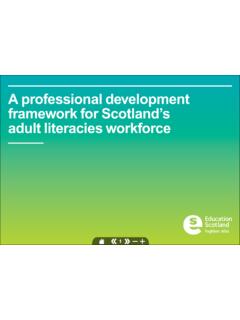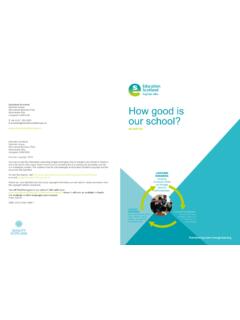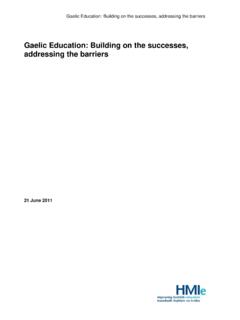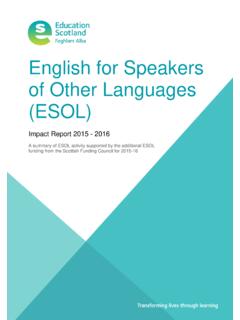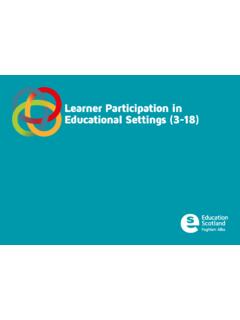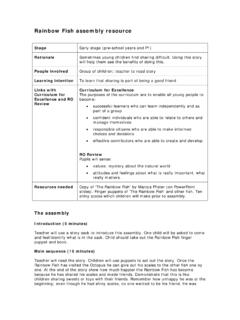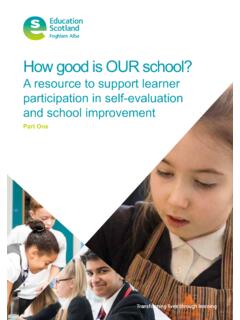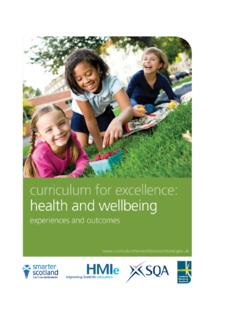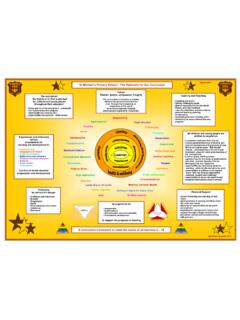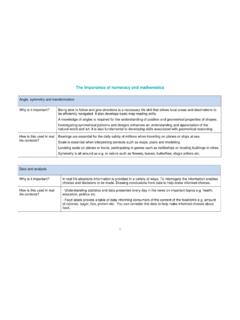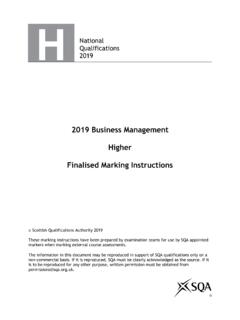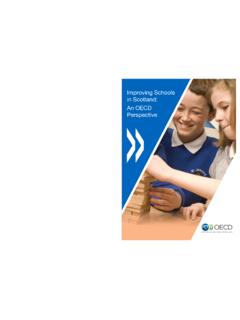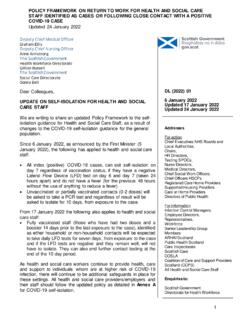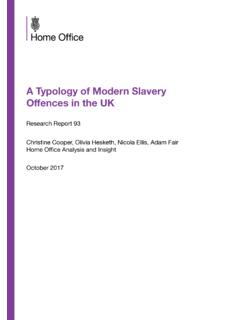Transcription of SCQF - Education Scotland | Education Scotland
1 Crown copyright 2010 How to use the ESOL initial assessment material .. 2 How to conduct the assessment .. 7 One-to-one assessment .. 8 Group assessment .. 10 ESOL literacy learners .. 13 Learner placement .. 14 Jagged profiles .. 15 Informing the learner of the outcome .. 16 Assessing the learner Section 1: Assessing speaking and listening .. 17 Procedures .. 17 Materials and assessment guide .. 17 Learner information form .. 18 Learner information form .. 23 Section 2: Assessing reading .. 27 Procedures .. 27 Tasks .. 29 Answers .. 37 Section 3: Assessing writing .. 39 Procedures .. 39 Tasks .. 40 Assessment guide .. 43 Section 4: Assessing literacy .. 44 Procedures .. 44 Materials .. 44 Appendices Appendix 1: SCQF Framework and Levels Equivalents.
2 50 Appendix 2: Speaking and listening exemplars (including videos) .. 52 Appendix 3: Writing exemplars .. 59 Appendix 4: Information relating to initial assessment and applications for naturalisation and settlement .. 87 1 Contents Introduction 1 scottish Qualifications Authority 2 scottish Credit and Qualifications Framework (SCQF) The Common European Framework 2 ESOL Initial Assessment: introduction This guide was produced by the scottish government s Lifelong Learning directorate in 2010 to support practitioners to undertake initial assessment with their learners. Its aim is to help standardise initial assessment approaches, so that the learner can be placed in the appropriate provision. It is recommended that providers adopt the principles, approaches and ESOL levels within the guide, and adopt or adapt the assessment materials to suit initial assessment procedures within their organisation.
3 This revised edition takes account of the changes to SQA1 qualifications. These materials are designed to be used in a wide variety of contexts and settings to assess learners from ESOL literacies beginners to entry to vocational and academic programmes of learning/courses. They can be used by providers across all sectors including colleges, community, voluntary organisations and schools. The guidance and materials in this pack are based on the principle that the main purpose of initial assessment is to ensure that all ESOL learners are placed in the most appropriate learning opportunity in order to make progress towards their specific language learning objectives and to achieve their personal, educational or employment goals.
4 Initial assessment is the first stage in a process of diagnostic assessment and the development of an Individual Learning Plan (ILP). This guide contains materials to assess all four skills: speaking, listening, reading and writing. Speaking and listening are assessed through a learner interview, which also plays a vital role in gathering information about the learner s past experience and in establishing their aims and aspirations for the future. This guide uses the table (Appendix 1 (page 50)) to relate the outcome of the initial assessment process to SCQF2 levels. The levels for each skill are matched against the SCQF and SQA NQ ESOL levels, both of which are derived from the Common European Framework (CEF).3 There are exemplars of the interview, the assessment of speaking and 4 3 ESOL Initial Assessment: introduction listening, and of learners writing to support standardisation.
5 Detailed commentaries accompany the exemplars and are matched to the assessment criteria used. Grammar is assessed through the tasks completed by the learner in the productive skills of speaking and writing and reference is made to the range of structures used and accuracy of production in the accompanying exemplars (Appendix 2 (page 52) and 3 (page 59)). The assessment can be used with individual learners or with groups, and detailed information on how to conduct the assessment in different scenarios is given to support the process. ESOL learners with dyslexia4It is also worth considering the possibility that some ESOL learners may have a specific learning difficulty such as dyslexia. Assessors should be aware of the common characteristics of adult dyslexia and discuss learning preferences with the learner at the outcome stage of their assessment.
6 This should be recorded on the Learner Information Form. Learners should always be assessedby a qualified and experienced ESOL tutor/teacher. ESOL staff must be familiar with the materials, criteria and levels used andshould use the exemplars to standardise. Staff new to the organisation should always have the opportunity toobserve an experienced ESOL tutor carrying out initial assessment. Staff carrying out initial assessment should match the learner to theappropriate learning opportunity and consider future progression routes. As well as gathering information on the level of the learners skills inreading, writing, speaking and listening, the tutor/teacher should be takingaccount of levels of confidence, attitudes to learning and preferredlearning styles. These factors will inform decisions about the mostappropriate learning opportunity.
7 Staff should also be sensitive to any key cultural, social or religiousconcerns that learners may have about particular the initial assessment Staff need to be aware that learners may be very nervous and that thismay be their first contact with the scottish Education system or, indeedany form of organised learning. In all organisations, a key part of the process is an interview and this mustbe set up to put learners at ease and to build confidence in their abilities. It is essential that the tutor/teacher gives a clear explanation of thepurpose and process so the learner understands why questions are beingasked. The tutor/teacher should create an environment which puts the learners atease. Translators and interpreters should be used as necessary. Listening, speaking, reading and writing should be assessed to establish alevel in each skill.
8 Learners should be given feedback on the initial assessment in a way thatbuilds their confidence and they should be clear about what the next stepswill be. There should always be an opportunity for the learner to ask questionsabout the learning opportunities available and the tutor/teacher s houldprovide clear information about any alternatives. Learners should leave the initial assessment with a document that clearlyindicates when and where they were assessed, their level andrecommended learning ESOL Initial Assessment: introduction What is effective practice in initial assessment?The following examples of effective practice have been incorporated into this guide: Responsibilities of the organisation and the ESOL tutor/teacher Further diagnostic assessment should take place when the learner joins alearning programme to ensure that they are on the right course.
9 If thelearner is not on the most suitable course, arrangements should be madeto transfer him/her, ensuring that any ILP goes with the learner. The information gathered during the initial assessment process shouldalways be given to the tutor/teacher who will be tutoring/teaching thelearner to begin the process of building an ESOL Initial Assessment: introduction After the initial assessment to assess the level of the learner s speaking and listening skills to begin to build up a profile of the learner s needs and is just the start of the process of building a profile which will continue when the learner has been placed in a suitable learning programme/course. Reading is assessed through a series of texts that gradually increase in difficulty. There is an easy to use guide on how to mark these and match to level.
10 Writing is assessed though a short written task and a judgement is made about level, again using criteria provided. The assessor may wish to talk about the subject of the written task with the learner beforehand, which in turn could help generate ideas for the learner to use in his/her writing. This will eliminate the worry of what can I write? and allow the learner to focus on how can I write about this topic? 6 ESOL Initial Assessment: how to use the guide In this initial assessment, all four skills - speaking, listening, reading and writing - are and listening are assessed through a short interview with the learner and a judgement is made about level using criteria provided. This part of the assessment has two aims: display welcome signs in different languages (see example below) make the location of the assessment as comfortable as possible organise a waiting area with refreshments and information for learners organise the layout for the interview so that it does not feel too formal forthe learner.
